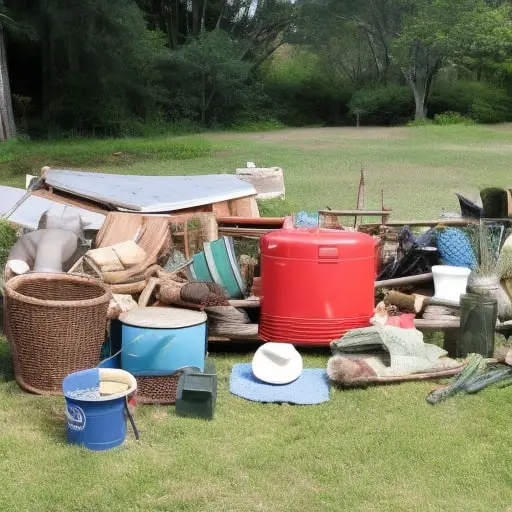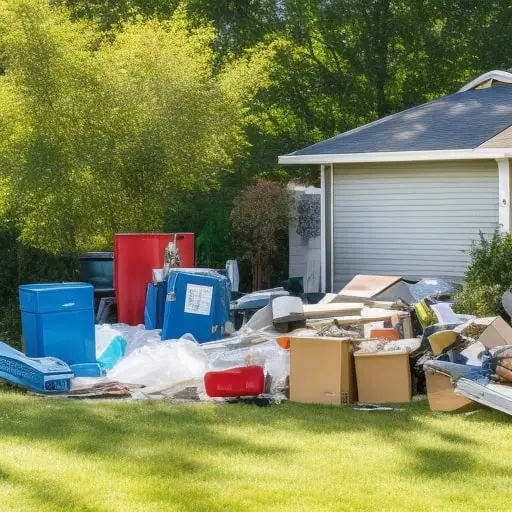Yes, you can move Neighbor’s stuff off your property.
As the owner of the land, you have the inherent right to expect that your property will not be encroached upon without your permission. But Banning someone from your property is a serious matter that requires careful consideration and adherence to the law. There are several reasons why you may want to ban someone from your property, such as if they have engaged in criminal activity, caused damage to your property, or violated your rules and policies. However, it is important to note that you cannot ban someone from your property based on their race, ethnicity, or national origin, as this would be considered discriminatory under civil rights legislation.
In this blog post, we will explore the rights and responsibilities of owners of adjoining properties, the concept of encroachments, and the question of whether you can move your neighbor’s belongings off your property. Understanding these aspects is crucial for navigating property-related conflicts in a legal and respectful manner.

Table of Contents
Rights and Responsibilities of Owners of Adjoining Properties
- Property ownership rights: As a property owner, you have the legal right to possess, use, and enjoy your land, including making improvements and engaging in activities within the boundaries of local regulations.
- Legal framework for boundaries and encroachments: Property boundaries are defined by local laws, providing clarity on your property’s limits and adjoining neighbors’ properties. Encroachments occur when a neighbor’s property extends beyond their legal boundary and encroaches on yours.
- Conflicts with encroachments: Encroachments can lead to disputes over property rights, boundaries, and usage, affecting your land’s functionality, aesthetics, and property value.
- Dealing with encroachments: Resolving encroachment issues requires understanding the legal framework, effective communication, and a willingness to find mutually acceptable solutions.
- Approach with respect and open-mindedness: When addressing encroachments, it is important to approach the situation respectfully, maintaining open-mindedness and a willingness to reach a mutually satisfactory resolution.
Understanding Encroachments
A. Encroachment and Its Different Forms:
Encroachment refers to the situation when a neighbor’s property extends beyond their legal boundaries and encroaches onto your property. Encroachments can take various forms, including:
- Fences: A common form of encroachment occurs when a neighbor’s fence is built beyond their property line and onto your land.
- Buildings and Structures: This includes instances where a neighbor’s building, shed, or other structures extend onto your property.
- Trees and Plants: Encroachment can also involve overhanging tree branches, roots, or plants that encroach onto your land.
- Personal Belongings: It’s not uncommon for neighbors to place their belongings, such as vehicles, outdoor furniture, or storage items, on your property without permission.
These different forms of encroachment can have various implications for your property and may require different approaches for resolution.
B. Common Reasons Behind Encroachments:
Encroachments can occur due to a variety of reasons, including:
- Misunderstandings: Sometimes, encroachments are unintentional and result from misunderstandings regarding property boundaries. Lack of clarity or accurate survey information can contribute to these situations.
- Neglect or Ignorance: Some encroachments occur when neighbors neglect to consider property boundaries or are unaware of the rules and regulations regarding property usage.
- Intentional Acts: In certain cases, encroachments may be intentional, where a neighbor deliberately extends their property onto yours, disregarding legal boundaries and your property rights.
Understanding the reasons behind encroachments can help inform your approach to resolving the issue and finding a suitable solution.
C. Importance of Addressing Encroachments to Protect Your Property Rights:
Addressing encroachments is vital for safeguarding your property rights and ensuring the proper use and enjoyment of your land. Here are a few reasons why addressing encroachments is important:
- Boundary Integrity: Encroachments can disrupt the accurate demarcation of property boundaries, potentially affecting the functionality, aesthetics, and value of your property. Resolving encroachments helps maintain the integrity of your property boundaries as defined by law.
- Legal Compliance: Encroachments may violate local zoning regulations, building codes, or property laws. By addressing encroachments, you ensure that both you and your neighbor are in compliance with applicable legal requirements, preventing any legal complications or liabilities.
- Conflict Prevention: Encroachments can lead to disputes and conflicts between neighbors. Timely resolution of encroachments helps maintain harmonious relationships, reducing tensions and potential legal battles.
- Property Value: Unresolved encroachments can impact the market value of your property.
Stop encroachments to protect your land. Respect your rights and the law. Be friendly with your neighbor. Find good solutions.
How to Get Your Neighbor to Remove Stuff Off Your Property
Communication as the First Step
- Approaching the Neighbor in a Polite and Respectful Manner: When addressing the issue of your neighbor’s belongings encroaching on your property, it’s crucial to approach them in a polite and respectful manner. Keep in mind that maintaining a positive relationship with your neighbor is beneficial for future interactions. Choose an appropriate time to discuss the matter when both parties are calm and receptive.
- Effective Ways to Express Concerns and Request Removal of Belongings: Clearly and calmly communicate your concerns to your neighbor, expressing how their encroachment affects your property and rights. Be specific about the items or structures involved and emphasize the importance of resolving the issue. Use “I” statements to avoid sounding accusatory and focus on finding a mutually agreeable solution. Propose a plan for the removal or relocation of their belongings and discuss potential timelines.
Understanding Local Laws and Regulations

- Researching Local Property Laws and Regulations: Take the time to research the specific property laws and regulations in your local area. Understanding your rights and the legal implications surrounding encroachments will help you navigate the situation more effectively. Familiarize yourself with relevant statutes, ordinances, and building codes that address property boundaries and encroachments.
- Consulting Legal Professionals for Advice: Consider seeking guidance from a real estate attorney or legal professional experienced in property matters. They can provide you with accurate and informed advice based on your local jurisdiction’s laws. An attorney can help you understand your legal options, review any documentation related to your property boundaries, and offer guidance on how to proceed.
Mediation as a Resolution Option
- Role of Mediators in Facilitating Discussions: A mediator helps you and your neighbor talk. They are neutral and fair. They promote good communication and solutions.Mediators are trained professionals skilled in managing conflicts and finding mutually acceptable solutions.
- Benefits of Finding Mutually Acceptable Solutions through Mediation: Mediation provides several advantages when attempting to resolve disputes with your neighbor. It allows for open and structured communication, ensuring that both parties have the opportunity to express their concerns and perspectives.Mediation makes you and your neighbor cooperate. You can understand each other better. You can find a fair solution. You can save time and money.
Mediation offers a less adversarial approach, helping to preserve neighborly relationships and promoting a positive atmosphere for future interactions. It can be a quicker and more cost-effective option compared to pursuing legal action, while still achieving a satisfactory outcome for all parties involved.
By following these steps—initiating respectful communication, understanding local laws and regulations, and considering mediation as a resolution option—you can increase the likelihood of getting your neighbor to remove their belongings from your property. Remember to approach the situation with patience and a willingness to find a mutually acceptable solution that respects your property rights and maintains a positive relationship with your neighbor.
Preventing Your Neighbor from Putting Stuff on Your Property
A. Clearly Mark Property Boundaries

- Importance of Visible Markers: Clearly marking your property boundaries is essential to prevent misunderstandings and encroachments. Install visible markers such as fences, boundary stones, or posts along the property lines. These markers serve as a visual indication of the boundaries and can help prevent unintentional encroachments by your neighbor.
- Periodic Inspections: Regularly inspect your property boundaries to ensure that the markers are intact and clearly visible. Over time, markers may become damaged or obscured by vegetation, requiring maintenance or reinstallation. By conducting periodic inspections, you can identify any potential encroachments early on and take appropriate action.
B. Communication and Addressing Concerns

- Open Communication: Maintain open lines of communication with your neighbor to establish a mutual understanding and respect for property boundaries. Foster a neighborly relationship by engaging in friendly conversations and addressing concerns promptly. Establishing a positive rapport can contribute to a more cooperative approach to property boundary issues.
- Addressing Concerns Promptly: If you notice any encroachments or belongings placed on your property without permission, address the issue with your neighbor as soon as possible. Politely and calmly express your concerns, providing them with a chance to rectify the situation. Prompt communication can prevent the encroachment from becoming a long-standing issue and demonstrates your commitment to protecting your property rights.
C. Legal Measures and Property Rights
- Understanding Property Rights: Educate yourself about your property rights and local laws regarding property boundaries. Familiarize yourself with any applicable zoning regulations or property ordinances that pertain to encroachments. Being aware of your rights will help you assert them effectively if a dispute arises.
- Seeking Legal Advice: In more complex cases or if the encroachments persist despite your attempts at communication, consult with a real estate attorney or legal professional. They can provide guidance on the specific laws in your jurisdiction and advise you on the best course of action. Legal professionals can help you understand your options, review any relevant documentation, and assist in pursuing appropriate legal remedies if necessary.
- Stop your neighbor from using your property: Mark boundaries and talk openly. Know your legal rights. Be respectful and willing.
What to Do If A Neighbor Is Damaging Your Property
A. Documenting the Damage
- Significance of Photographic Evidence and Record Keeping: When dealing with property damage caused by a neighbor, it is crucial to gather evidence through photographs. Take clear, detailed pictures that clearly show the extent of the damage. Additionally, maintain detailed records of incidents, including dates, times, and descriptions of the damage. These records can be invaluable when presenting your case and seeking a resolution.
- Documenting Related Incidents or Conversations: In addition to photographic evidence, keep a record of any incidents or conversations related to the property damage. This includes any discussions with the neighbor regarding the damage, attempts to resolve the issue, or any other relevant interactions. These records can help establish a timeline of events and support your claims should legal action become necessary.
B. Seeking Legal Advice
- Importance of Consulting Real Estate Attorneys: If the damage caused by your neighbor is significant or ongoing, it is advisable to seek legal advice from a real estate attorney. They specialize in property law and can provide you with expert guidance on your rights, potential legal actions, and the steps to take in protecting your property.
- How Attorneys Can Guide Property Owners in Protecting Their Rights: Real estate attorneys can help you understand the legal options available to you. They can assess the damage, review relevant documents, and advise you on the best course of action. Lawyers can talk, warn, and sue for you. Their expertise ensures that you have a strong legal advocate fighting for your rights.
C. Potential Legal Actions
- Exploring Options such as Filing a Lawsuit: In severe cases where other attempts at resolution have failed, filing a lawsuit may be necessary to address the property damage caused by your neighbor. A lawsuit can seek compensation for the damages, restoration of the property, or an injunction to prevent further damage. However, legal action should be considered a last resort after exhausting all other avenues.
- Potential Outcomes and Legal Processes Involved: When filing a lawsuit, it is essential to understand the potential outcomes and the legal processes that will be involved. This includes gathering evidence, presenting your case in court, and potentially going through a trial. Consulting with your attorney will help you navigate these processes and increase your chances of a successful outcome.
Moving Your Neighbor’s Stuff: Legal Considerations and Consequences
A. Trespassing Charges
- Legal Offense of Moving Someone Else’s Property Without Permission: Moving your neighbor’s belongings without their consent is considered trespassing. Trespassing involves unlawfully entering someone’s property or interfering with their possessions. Don’t act on your own. It can be illegal.
- Potential Legal Consequences and Liabilities: Engaging in unauthorized removal of your neighbor’s belongings can lead to legal consequences such as civil lawsuits and criminal charges. You may be held liable for damages or face penalties imposed by the legal system. It is crucial to respect your neighbor’s property rights and pursue legal channels to resolve any disputes.
B. Respecting Your Neighbor’s Rights
- Importance of Respecting Boundaries and Pursuing Legal Channels: Respecting boundaries is essential in maintaining a harmonious relationship with your neighbor. While it can be frustrating to have their belongings on your property, it is important to approach the situation within the bounds of the law. By respecting their rights and pursuing legal channels, you demonstrate your commitment to resolving the issue in a fair and just manner.
- Need for Patience and Adherence to Legal Procedures: Resolving property disputes takes time and patience. Follow legal procedures and get professional advice. This makes your actions lawful. Be patient and explore options. Find a good resolution.
Resolving Encroachment Issues
A. Property Surveys
- Role of Professional Surveyors in Accurately Determining Property Boundaries: Professional surveyors play a crucial role in resolving encroachment issues by accurately determining property boundaries. They use specialized tools and techniques to survey the land, assess existing markers, and create precise boundary measurements. Their expertise provides an objective assessment of the property boundaries, aiding in the resolution process.
- How Property Surveys Can Aid in Resolving Encroachment Issues: Surveys show the property boundaries. They can solve encroachment disputes. Show the survey to your neighbor. Respect each other’s rights.
Also see – Notice to Remove Mobile Home from Property
B. Legal Action as a Last Resort
- Importance of Exhausting Other Options: Before resorting to legal action, it is crucial to exhaust other options for resolving encroachment issues. This includes open communication, negotiation, and mediation. Legal action should only be pursued when all other attempts at resolution have been unsuccessful or if the encroachment poses a significant threat to your property rights.
- General Guidance on Pursuing Legal Remedies for Encroachments: If all other options have been exhausted, pursuing legal remedies may involve filing a lawsuit or seeking an injunction to address the encroachment. It is important to consult with your attorney, who can guide you through the legal process, provide appropriate documentation, and represent your interests in court if necessary.
Conclusion:
A. Summarize the Key Points Discussed: Throughout this blog post, we have explored various aspects of dealing with neighbor-related property issues, including encroachments and property damage. We discussed the importance of understanding property rights, documenting incidents, seeking legal advice, and exploring alternative dispute resolution methods.
B. Reiterate the Importance of Understanding Property Rights and Legal Processes: Your property rights are important. Learn the legal steps to solve disputes. Protect your interests and keep good neighbors.
C. Encourage Seeking Professional Advice and Maintaining Open Communication with Neighbors: Encountering property issues with neighbors can be challenging, but it is essential to seek professional advice from real estate attorneys or legal experts. They can provide tailored guidance based on your specific circumstances. Additionally, maintaining open lines of communication with your neighbors fosters understanding and can lead to mutually beneficial resolutions.
Remember, the information provided in this blog post is intended to serve as a general guide and should not be considered legal advice. Every situation is unique, and it is important to consult with legal professionals for personalized advice that aligns with the laws and regulations in your jurisdiction.

Can I simply say what a relief to search out somebody who actually knows what theyre speaking about on the internet. You definitely know tips on how to bring an issue to mild and make it important. More people need to learn this and perceive this facet of the story. I cant believe youre no more in style because you undoubtedly have the gift.